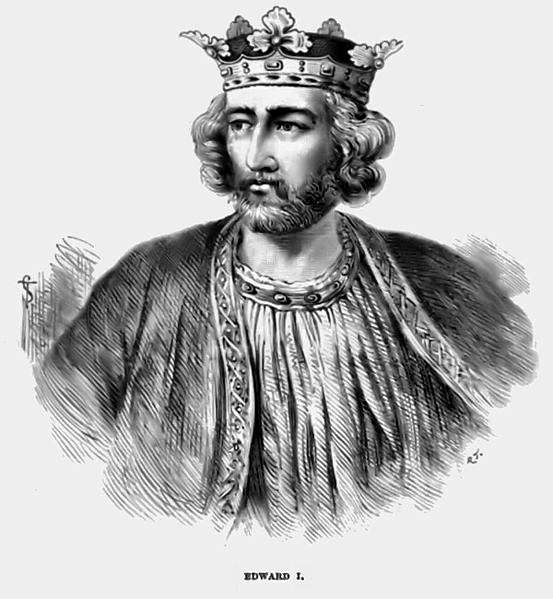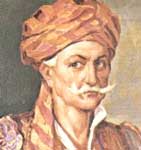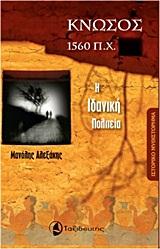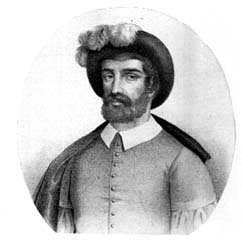
4 Αυγούστου 1265 Δεύτερος
πόλεμος των βαρώνων: μάχη του Ίβσαμ. Ο στρατός του πρίγκιπα Εδουάρδου
(μελλοντικού βασιλιά Εδουάρδου Α' της Αγγλίας) νικά τις δυνάμεις των
επαναστατημένων βαρόνων, σκοτώνοντας τον επικεφαλής τους, Σάιμον ντε
Μόνφορτ, 6ο κόμη του Λέστερ, και πολλούς από τους συμμάχους του.
Με
την ονομασία Πόλεμος των Βαρώνων ή Δεύτερος πόλεμος των βαρώνων έμεινε
στην ιστορία της Αγγλίας ο τριετής εμφύλιος πόλεμος που ξέσπασε στη
περίοδο 1264-1267 με αφορμή τη δυσφορία των Άγγλων βαρώνων (κατώτερης
αριστοκρατίας) για την άφρονη και σπάταλη πολιτική του Βασιλέως Ερρίκου
Γ' της Αγγλίας.
Κύριος όμως λόγος της εξέγερσης εκείνης ήταν η
προσπάθεια των βαρώνων να πετύχουν εκ μέρους του βασιλέως τη τήρηση των
Διατάξεων της Οξφόρδης, οι οποίες όμως με τη ρύθμιση της Αμιένης το 1264
κηρύχθηκαν άκυρες από τον βασιλέα της Γαλλίας Λουδοβίκο Θ'. Έτσι,
αναλαμβάνοντας επικεφαλής της ένοπλης εξέγερσης, ο βαρόνος Σιμόν ντε
Μονφόρ κατάφερε στη «μάχη του Λιούις» (Μάιος 1264), που ακολούθησε να
συλλάβει τον Βασιλέα και να τον θέσει υπό περιορισμό. Για ένα σχεδόν
χρόνο και μέχρι τη μάχη του Ίβσαμ, (4 Αυγούστου 1265), όπου και
σκοτώθηκε ασκούσε σχεδόν τον πλήρη έλεγχο της Αγγλίας.
Τελικά με
το διάταγμα (Dictum), του Κένιλγουερθ, το 1266, έγιναν κάποιες
διευθετήσεις και στη συνέχεια με το «ψήφισμα (Statue) του Μάλμπορο», τον
επόμενο χρόνο, ικανοποιήθηκαν μερικά οικονομικά αιτήματα των βαρώνων.
Β΄ πόλεμος των Βαρόνων
Ανδριάντες του βασιλιά της Αγγλίας Εδουάρδου Α' και της συζύγου του Ελεονόρας της Καστίλης στον καθεδρικό ναό του Λίνκολν
Την
περίοδο 1264 - 1267 ξέσπασε εμφύλια σύγκρουση γνωστή σαν Δεύτερος
πόλεμος των βαρώνων, οι βαρόνοι υπό την ηγεσία του Σίμονος ντε Μοντφόρντ
συγκρούστηκαν με τα βασιλικά στρατεύματα. Στην πρώτη φάση ο Εδουάρδος
ανακατέλαβε το Γκλόστερ, ο Ροβέρτος του Φέρρερ κόμης του Ντέρμπι ήρθε να
να βοηθήσει τους επαναστάτες και ο πρίγκηπας ήρθε σε συμφωνία μαζί του η
οποία σύντομα έσπασε, ο Εδουάρδος κατέλαβε το Νορθάμπτον από τον γιο
του Μoντφόρτ Σίμον πριν ξεκινήσει εκστρατεία για αντίποινα στα εδάφη του
Ντέρμπι. Η πρώτη μάχη ανάμεσα στους βαρόνους και τις βασιλικές δυνάμεις
δόθηκε στο Λέβ στις 14 Μαΐου 1264, ο πρίγκηπας διηύθυνε πολύ καλά την
δεξιά πτέρυγα του στρατεύματος νικώντας τον εχθρό αλλά απερίσκεπτα τους
καταδίωξε με αποτέλεσμα να ανασυγκροτηθούν και στην επιστροφή τους ο
Εδουάρδος ηττήθηκε. Στην Συνθήκη του Λέβ που ακολούθησε ο Εδουάρδος και
ο Ερρίκος του Αλμαίν μεταφέρθηκαν αιχμάλωτοι στο Μοντφόρντ. Ο στρατός
ήταν μοιρασμένος σε τρία τμήματα, στα αριστερά οι οπλισμένοι ιππότες
κρατούσαν ένα γυμνό σώμα, στο μέσο ένα γυμνό σώμα κείτεται με κομμένα
χέρια και πόδια και στα δεξιά υπήρχαν πολλά πτώματα με πανοπλίες. Ο
Εδουάρδος βρισκόταν στην φυλακή μέχρι τον Μάρτιο, στην συνέχεια μπήκε σε
αυστηρή επιτήρηση αλλά δραπέτευσε και ένωσε τις δυνάμεις του με τον
κόμη του Γκλόστερ ο οποίος αυτή την φορά πήγε με το μέρος του. Οι
δυνάμεις του Μοντφόρτ όμως ήταν λίγες, ο Εδουάρδος ανακατέλαβε εύκολα
του Ουόρκεστερ και το Γκλόστερ. Ο Μοντφόρτ συμμάχησε με τον Λιουέλιν,
ενώθηκε με τις δυνάμεις του γιου του Σίμον και ο Εδουάρδος κινήθηκε
αιφνιδιαστικά στο κάστρο του Κένιλγουερθ όπου βρισκόταν ο νεαρός
Μόντφορτ. Στην μάχη του Έβεσαμ που ακολούθησε στις 4 Αυγούστου 1265 ο
βασιλικός στρατός ήταν αυτή την φορά σημαντικό ισχυρότερος, οι βαρόνοι
συνετρίβησαν ενώ ο κόμης του Μοντφόρτ σκοτώθηκε και ακρωτηριάστηκε στο
πεδίο της μάχης. Ο Εδουάρδος σταδιακά διδάχθηκε από τα παθήματα του τόσο
που κέρδισε μεγάλο σεβασμό από τους συγχρόνους του, προσπάθησε να έρθει
σε συμφωνία με τον νεώτερο Μοντφόρτ στο Λινκολνσάιρ, ένα τμήμα των
επαναστατών βρισκόταν στο κάστρο του Κένιλγουερθ περιμένοντας την
υπογραφή της συνθήκης για να παραδοθούν. Ο εμφύλιος πόλεμος των βαρόνων
τελείωσε με το Διάταγμα του Κένιλγουερθ, οι δυο πλευρές ήρθαν σε
συμφωνία αλλά ο Εδουάρδος δεν συμμετείχε επειδή σχεδίαζε την
Σταυροφορία.
4 août 1265 Seconde guerre des barons : bataille d'Evesham. L'armée du prince Édouard (futur roi Édouard Ier d'Angleterre) bat les forces des barons rebelles, tuant leur chef, Simon de Montfort, 6e comte de Leicester, et nombre de ses alliés. Appelée la guerre des barons ou la deuxième guerre des barons, la guerre civile de trois ans qui a éclaté dans la période 1264-1267 a été laissée dans l'histoire de l'Angleterre en raison de l'inconfort des barons anglais (aristocratie inférieure) pour les téméraires et politique de gaspillage du roi Henri III Angleterre. Mais la raison principale de cette rébellion était la tentative des barons d'obtenir au nom du roi le respect des décrets d'Oxford, qui, cependant, avec le règlement d'Amiens en 1264, furent déclarés invalides par le roi de France, Louis IX. . Ainsi, assumant la direction de la rébellion armée, le baron Simon de Montfort réussit la « bataille de Lewis » (mai 1264), qui s'ensuivit en capturant le roi et en le mettant sous séquestre. Pendant près d'un an et jusqu'à la bataille d'Evesham, (4 août 1265), où il fut tué, il exerça un contrôle presque complet sur l'Angleterre. Enfin, avec l'Édit (Dictum), de Kenilworth, en 1266, quelques arrangements furent pris puis avec la "Statue" de Marlborough, l'année suivante, certaines demandes financières des barons furent satisfaites. Dans la période 1264 - 1267 éclate un conflit civil connu sous le nom de Seconde Guerre des Barons, les barons sous la direction de Simon de Montford se heurtent aux troupes royales. Dans la première phase, Edward a repris Gloucester, Robert de Ferrer, comte de Derby, est venu en aide aux rebelles et le prince est parvenu à un accord avec lui qui a rapidement échoué, Edward a capturé Northampton au fils de Montfort, Simon, avant de faire campagne pour des représailles dans les terres de Derby. La première bataille entre les barons et les forces royales eut lieu à Lev le 14 mai 1264, le prince dirigea très bien l'aile droite de l'armée en battant l'ennemi mais les poursuivit imprudemment les faisant se regrouper et à leur retour Edward fut vaincu. Dans le traité de Lewes qui a suivi, Edward et Henry d'Almain ont été faits prisonniers à Montford. L'armée était divisée en trois divisions, à gauche les chevaliers armés tenaient un corps nu, au milieu un corps nu gisait avec les bras et les jambes coupés, et à droite il y avait plusieurs cadavres en armure. Edouard est en prison jusqu'en mars, puis placé sous haute surveillance mais s'évade et s'associe au comte de Gloucester qui l'accompagne cette fois. Mais les forces de Montfort étaient peu nombreuses, Edward reprit facilement Worcester et Gloucester. Montfort s'allia avec Llewelyn, rejoignit les forces de son fils Simon, et Edward fit un mouvement surprise sur le château de Kenilworth où se trouvait le jeune Montfort. Lors de la bataille d'Evesham qui s'ensuivit le 4 août 1265, l'armée royale fut cette fois nettement plus forte, les barons furent mis en déroute tandis que le comte de Montfort fut tué et mutilé sur le champ de bataille. Edward a progressivement appris de ses souffrances tellement qu'il a gagné un grand respect de ses contemporains, il a essayé de parvenir à un accord avec le jeune Montfort dans le Lincolnshire, une partie des rebelles étaient au château de Kenilworth attendant la signature du traité de reddition. La guerre civile baronniale s'est terminée avec l'édit de Kenilworth, les deux parties sont parvenues à un accord mais Edward n'a pas participé car il planifiait la croisade.
4 August 1265 Second Barons' War: Battle of Evesham. The army of Prince Edward (future King Edward I of England) defeats the forces of the rebel barons, killing their leader, Simon de Montfort, 6th Earl of Leicester, and many of his allies. Under the name Barons' War or Second Barons' War, the three-year civil war that broke out in the period 1264-1267 was left in the history of England on the occasion of the discomfort of the English barons (lower aristocracy) for the reckless and wasteful policy of King Henry III England. But the main reason for that rebellion was the attempt of the barons to achieve on behalf of the king the observance of the Oxford Decrees, which, however, with the regulation of Amiens in 1264, were declared invalid by the king of France, Louis IX. Thus, assuming the leadership of the armed rebellion, Baron Simon de Montfort succeeded in the "battle of Lewis" (May 1264), which followed in capturing the King and placing him under confinement. For almost a year and until the battle of Evesham, (August 4, 1265), where he was killed, he exercised almost complete control over England. Finally, with the Edict (Dictum), of Kenilworth, in 1266, some arrangements were made and then with the "Statue" of Marlborough, the following year, some financial demands of the barons were satisfied. In the period 1264 - 1267 a civil conflict known as the Second Barons' War broke out, the barons under the leadership of Simon de Montford clashed with the royal troops. In the first phase Edward recaptured Gloucester, Robert of Ferrer Earl of Derby came to the aid of the rebels and the prince came to an agreement with him which soon broke down, Edward captured Northampton from Montfort's son Simon before campaigning for reprisals in the lands of Derby. The first battle between the barons and the royal forces was fought at Lev on 14 May 1264, the prince led the right wing of the army very well defeating the enemy but recklessly pursued them causing them to regroup and on their return Edward was defeated. In the ensuing Treaty of Lewes Edward and Henry of Almain were taken prisoners to Montford. The army was divided into three divisions, on the left the armed knights were holding a naked body, in the middle a naked body lay with severed arms and legs, and on the right there were several corpses in armor. Edward was in prison until March, then placed under strict surveillance but escaped and joined forces with the Earl of Gloucester who this time went with him. But Montfort's forces were few, Edward easily recaptured Worcester and Gloucester. Montfort allied himself with Llewelyn, joined his son Simon's forces, and Edward made a surprise move on the castle of Kenilworth where the young Montfort was. In the ensuing Battle of Evesham on 4 August 1265 the royal army was this time significantly stronger, the barons were routed while the Earl of Montfort was killed and maimed on the battlefield. Edward gradually learned from his sufferings so much that he gained great respect from his contemporaries, he tried to come to an agreement with the younger Montfort in Lincolnshire, a part of the rebels were in Kenilworth Castle waiting for the signature of the treaty to surrender. The baronial civil war ended with the Edict of Kenilworth, the two sides came to an agreement but Edward did not participate because he was planning the Crusade.









